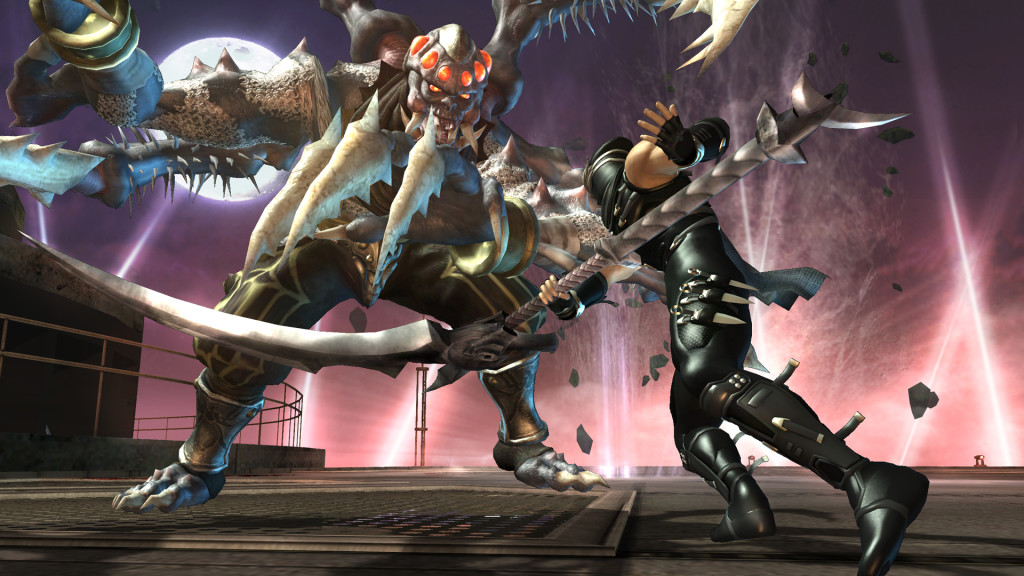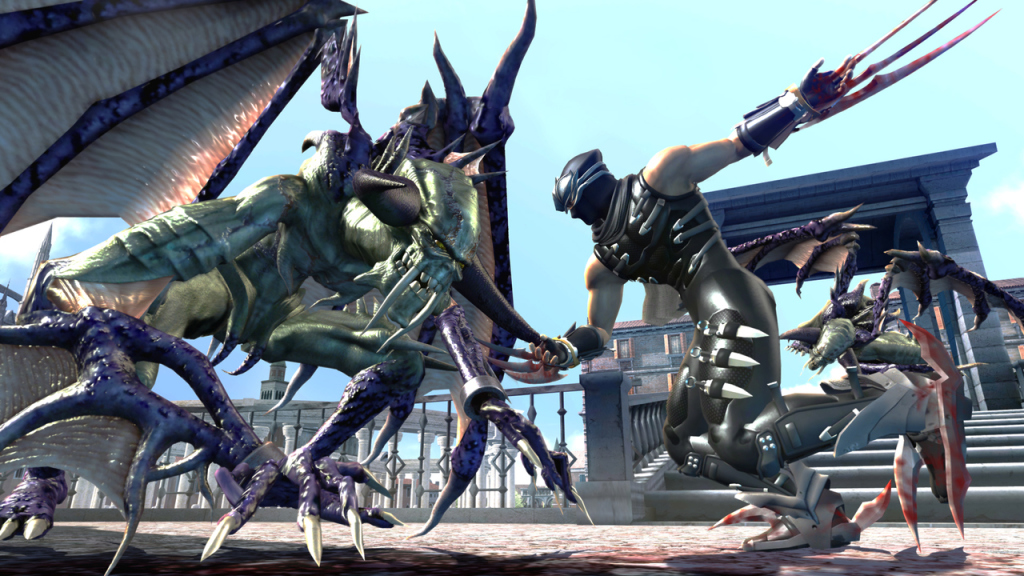Last updated on January 26, 2015
Ninja Gaiden II must be one of the most exhausting, grueling game experiences I’ve played in a long time. It contains elements that frequently strike me as brilliant, while also saddling itself with all sorts of problems that dampen their overall effect. It presents an incredibly stiff challenge to any without the dedication to finish, but also frequently descends into the dreaded action game realm of “unfairness”. Equal parts thrilling and frustrating, you really need to take the good with the bad in this whole ninja-survivalist experience. While that would normally ward most people off, I think it’s worth playing simply due to its unique approach to the whole action-combat genre.
Ninja Gaiden II, from its outset, demands respect and mastery. If you are not up for the odds, for the challenge, and for the seeming unfairness of its various scenarios, then don’t bother playing. As you learn the game’s combat system, you’ll find you actually hold all the tools required to make a successful offense. That, in a sense, seems to show us the real motivation at the heart of this series. The more you know, the more likely you will win, and that remains true of the whole Ninja Gaiden series (including the earlier entries). I call it a video game endurance match; for a long time, you won’t actually have any kind of fun. Some things in life (even the unfair stuff) require that kind of dedication, and not backing down will prove a far better prospect than running away. Step up to the task, and it proves far more rewarding. I don’t often use the King James Version, but I think I’ll make an exception for 1 Corinthians 9, just for the poetic nature of the language:
24 Know ye not that they which run in a race run all, but one receiveth the prize? So run, that ye may obtain.
25 And every man that striveth for the mastery is temperate in all things. Now they do it to obtain a corruptible crown; but we an incorruptible.
26 I therefore so run, not as uncertainly; so fight I, not as one that beateth the air:
27 But I keep under my body, and bring it into subjection: lest that by any means, when I have preached to others, I myself should be a castaway.
Paul strives for mastery over his thoughts and his body in order to strive for the incorruptible crown. That’s the kind of dedication you need for a game like Ninja Gaiden II: blatantly unfair, yet just a presentation of a stiff, unfair challenge can really light a fire under you. It did for me, anyway!

Let’s talk about the first game, though, since a comparison is pretty much necessary to make any notable criticism The original game in the Ninja Gaiden reboot series became known for its difficulty and challenge. With enemies that constantly attacked and grabbed you, a lack of health regeneration, and long spaces of no items/save points to speak of, the game required a certain level of consistency to finish. Ninja Gaiden emphasized resource management, as a shop wasn’t always available nearby to restock on necessary items. You need to space out those health powerups, or you might find yourself with nothing but your skill.
Each save point gave you a breather, even if they didn’t restore your health, but you knew you had hit the designer’s predetermined checkpoint and fulfilled their expectations of you. At the same time, Ninja Gaiden spaced out its intense combat via exploration and light puzzle solving, as did its predecessor Devil May Cry. Good games know the importance of “quiet time”, merely allowing the player a break in the action or time to relax in-between the combat. Ninja Gaiden’s semi-open world eventually gave you that “eureka” moment you always have when you find yourself in a previously unexplored area. Even if the game’s totally linear, it doesn’t feel that way! That gave the world a sense of place and pacing, which helps immensely when each combat sequence could prove a life-or-death event.
That combat, of course, remains the main event. Almost every enemy presents a wide array of attacks which, if underestimated, can kill you quickly. You need to prioritize threats, figure out when an enemy will grab you, and eliminate them quickly. Avoiding grabs at all costs meant that blocking, which cannot be broken in the original game, ended up balancing the combat into a sort of focused flow. On the other hand, Ninja Gaiden never really presented a penchant for allowing players the freedom to style on their foes or practice combos; you use the most efficient attacks, and use them until everything dies. That includes Ninpo, magic attacks which allowed you to get a breather and usually eliminate several foes. They are balanced by the lack of Ninpo energy throughout the game, so you needed to use them wisely.
The Izuna Drop and the Flying Swallow attacks proved incredibly effective for most smaller enemies, but the larger types also balanced that element in combat scenarios. Someone thought long and hard about how to prevent any technique from being too optimal; they even re-released the game in the form of Ninja Gaiden Black, fixing the dominance of the Flying Swallow. Eventually you found out how to use Ultimate Techniques, which opened up another strategic element in the use of essence (which drops off enemies and can be used as currency) for quick combat resolution.
What works about it, in contrast to the more stylish action games (Devil May Cry, Platinum Games) is that there’s no real combo “system”, nor tracking of which combos you use. It never forces you to learn a variety of combos for fun, but by necessity. Each weapon might give you a vast moveset, but who really has the time to look that up or remember those? Usually, most players end up finding the optimal moves that kill enemies the quickest. In this sense, Ninja Gaiden’s diverse moveset act more as tools for each situation, and less like matters of personal preference or fun. Think of it like powerups in an old school NES game, rather than an aesthetic choice. Your weapon means your strategy, not what you personally like. That gives the whole game a much more clear sense of challenge and minimalism than most games in this genre. You look stylish by playing well, not by picking weapon X.
It doesn’t hurt that every looks cool and plays great! The game had a sense for friction and weight, as every hit sounds and hits hard. Tiny vibrations in the controller emphasize the weight and impact of every blow, which really throws you into the action when you have audio, visual, and tactile feedback combining into a wonderful whole. Everything worked together, and worked well! If you wanted pure combat, you could always use the Mission Mode (although Itagaki apparently was against the idea). It works in itself, but the pacing really seems necessary to space out all this fighting. Too much of a good thing can often break a longer game’s pacing, and 10-15 hours of intense combat action, while great on paper, isn’t always functional in practice.

